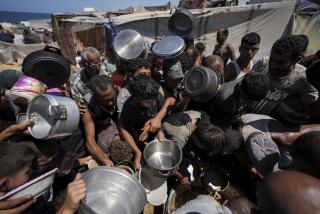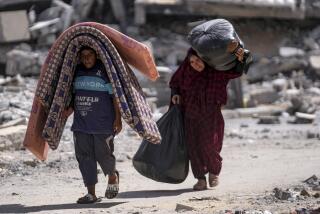Serbs Round Up, Expel Muslims in ‘Safe Area’
- Share via
SARAJEVO, Bosnia-Herzegovina — Fresh from their capture of the Srebrenica “safe area,” Bosnian Serb forces on Wednesday took control of a United Nations peacekeeping camp, rounding up and expelling thousands of desperate, terrified Muslim refugees, U.N. officials said.
A triumphant Gen. Ratko Mladic, commander of the Bosnian Serb army, rode into the enclave at the head of a convoy of 30 to 40 trucks and ordered women, children and the elderly to abandon the Dutch compound where 30,000 to 40,000 Muslims had sought refuge from invading Serbian nationalists.
Male refugees older than 16 were separated from the group by Bosnian Serbs looking for government army soldiers and were to be held for interrogation, U.N. officials said.
“This is an outrageous example of ‘ethnic cleansing’ . . . unprecedented in a U.N. safe area,” said Kris Janowski, spokesman for the Office of the U.N. High Commissioner for Refugees. “Tens of thousands of displaced persons are being delivered to the mercy of the Bosnian Serbs.”
In the long catalogue of Bosnian war atrocities, this was the largest single forced expulsion in two years, U.N. officials said, and capped a disastrous episode that saw the United Nations for the first time lose to the Bosnian Serbs a designated haven for civilians.
The U.N. presence in Bosnia-Herzegovina was designed to stop the sort of mass ethnic deportations that shocked the world earlier on in the 39-month-old war.
“It was quite a horrifying scene--there was screaming and crying and panicking” as families were torn apart, said Stephane Oberreit of the Doctors Without Borders relief group, which is in radio contact with two medical team workers who witnessed the expulsions.
The Bosnian Serbs captured Srebrenica on Tuesday, overcoming nominal resistance from lightly armed Dutch troops and a small contingent of the Bosnian government army. NATO warplanes also failed to deter the advancing Serbs.
The loss of Srebrenica exposed the utter impotence of the U.N. mission here and pushed the world organization closer to withdrawing altogether from the Balkans, despite the blood bath that would probably follow.
Bosnian President Alija Izetbegovic, furious that the United Nations could not save Srebrenica, said his Muslim-led government will probably not renew the mandate that allows the U.N. presence in Bosnia. It expires in November, and he left open the possibility of asking the United Nations to leave sooner.
Izetbegovic demanded that the United Nations and the North Atlantic Treaty Organization use force to restore the Srebrenica safe area, and he called for the resignation of U.N. special envoy Yasushi Akashi, whom the Bosnians accuse of doing too little too late while appeasing the nationalist Serbs. “The hesitation of the U.N. has brought us to this tragedy,” Izetbegovic said in a news conference at a Sarajevo hotel.
The president’s call seemed to have support in France, but only there. French President Jacques Chirac pressed for military action to recapture Srebrenica, possibly by the new 12,500-member European rapid-reaction force, but he was alone in his readiness to use force.
Akashi quickly threw cold water on the idea, telling reporters in Zagreb, Croatia’s capital, that restoring the safe area through force was not possible. Not only is the rapid-reaction force still not ready, but Mladic has threatened to kill hostage peacekeepers and shell civilian refugees if NATO air strikes resume.
Despite U.N. condemnation of the offensive, Bosnian Serb leader Radovan Karadzic told reporters he had no intention of pulling out of the former enclave. “Srebrenica is our country,” Karadzic said.
The rebel Serbs late Wednesday were holding at least 48 Dutch peacekeepers hostage. All 400 or so inside the compound are also essentially captive. The Bosnian Serbs had opened the Srebrenica offensive last week by swooping into the U.N. observation posts that form a ring around the enclave.
By Tuesday, the tank and artillery assault was in full swing. Almost 30,000 refugees fled and huddled around the U.N. compound in Potocari, about three miles north of Srebrenica, while more were on the way early Wednesday. But barely had they escaped the Bosnian Serb offensive when they watched nationalist Serb gunmen enter Potocari.
A couple hundred rebel Serbs surrounded the refugees on Wednesday, guns drawn and pointed. Men were “screened” as the Bosnian Serbs searched for what they called war criminals, while the women and children were herded onto buses and trucks, witnesses said.
Mladic, dressed in camouflage and flanked by bodyguards, was shown on Bosnian Serb television walking among the cowering crowd, assuring the refugees they had nothing to fear.
“You don’t have to be afraid of anything,” he said as they were herded onto buses. “Slowly. Please let the women and children in front of you. . . . No panic please. . . . Don’t be afraid. No one will harm you.”
By Wednesday night, about 3,000 women and children in three convoys of Bosnian Serb trucks had been dispatched for the government-held town of Kladanj, about 30 miles northwest of Srebrenica. The nationalist Serbs granted the United Nations permission to place one peacekeeper on each vehicle.
An estimated 1,000 refugees arrived in Kladanj on Wednesday night, forced to walk the last 10 miles across the front lines. Television pictures showed women in head scarves carrying babies or leading children by the hand. The town was shelled, presumably by the Bosnian Serbs, as they arrived, Oberreit, the relief official, said.
But 88 people who were wounded in the exodus from Srebrenica or in the shelling that preceded it remained at the tiny field hospital inside the Dutch compound, where medical supplies were scarce. Food, mostly U.N. soldiers’ rations, will run out today, officials said, and the people who remained at Potocari were desperately hungry and dirty.
(BEGIN TEXT OF INFOBOX / INFOGRAPHIC)
Where the ‘Safe Areas’ Stand
The status of the six U.N.-declared “safe areas” in Bosnia-Herzegovina:
1) Srebrenica: The town on Tuesday became the first to fall to rebel Serbs. As many as 42,000 inhabitants fled to a nearby village. The rebels seized them there, holding the men for interrogation.
2) Sarajevo: Cut off by a Serb siege for three years, the capital has lost half its prewar population of 526,000 people. Government soldiers launched an offensive last month.
3) Bihac: Bihac is surrounded by Bosnian Serbs to the east and south and by Serb-held territory in Croatia to the north and west.
4) Tuzla: This city was spared Serb attacks until May 25. Then rebel forces, retaliating for NATO attacks on a Serb ammunition dump, attacked with mortars, killing more than 70 people.
5) Gorazde: Site of the first NATO airstrikes in April, 1994, aimed at halting a Serb advance similar to the attack on Srebrenica. The population of Gorazde has mushroomed from 37,000 before the war to 60,000.
6) Zepa: The population of this mountain town, 6,000 before the war, has nearly tripled to 16,000 with an influx of refugees.
More to Read
Sign up for Essential California
The most important California stories and recommendations in your inbox every morning.
You may occasionally receive promotional content from the Los Angeles Times.














